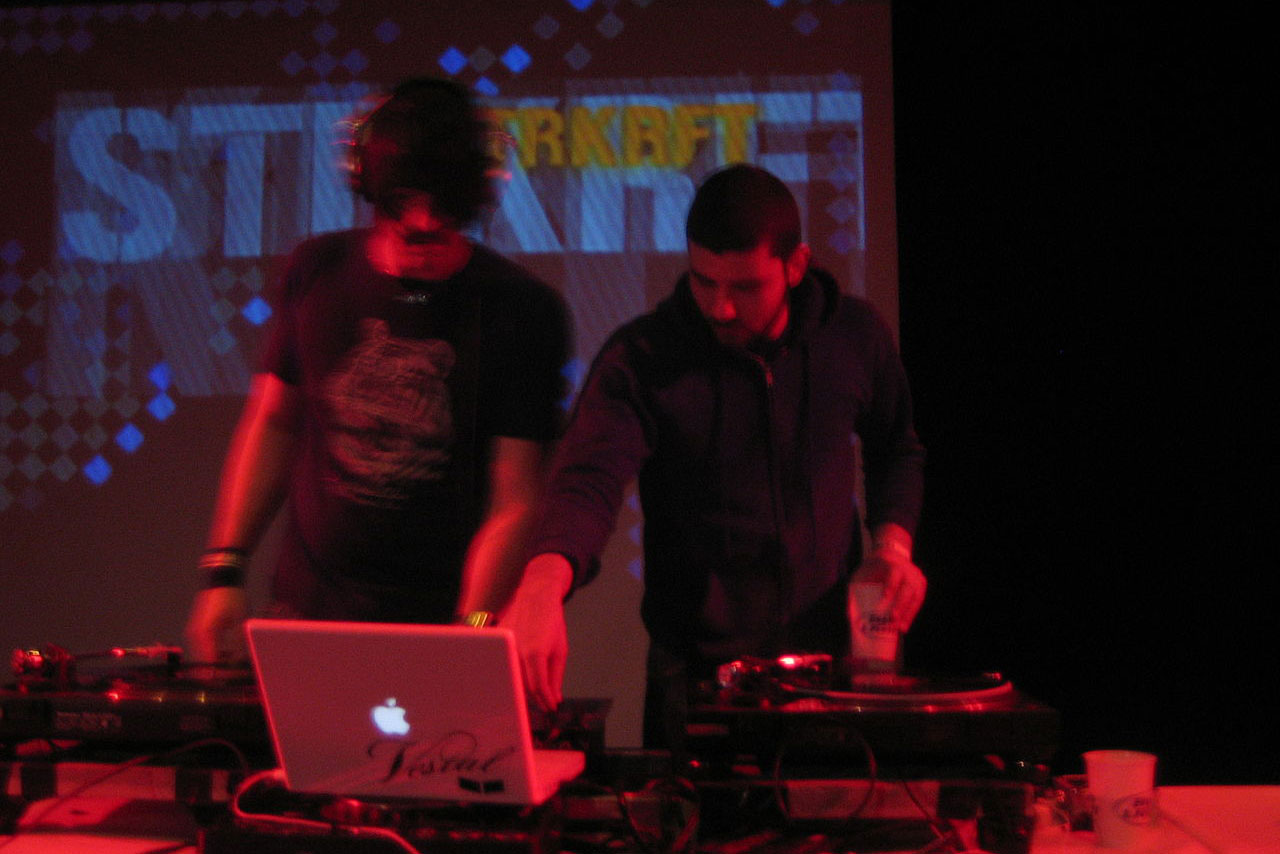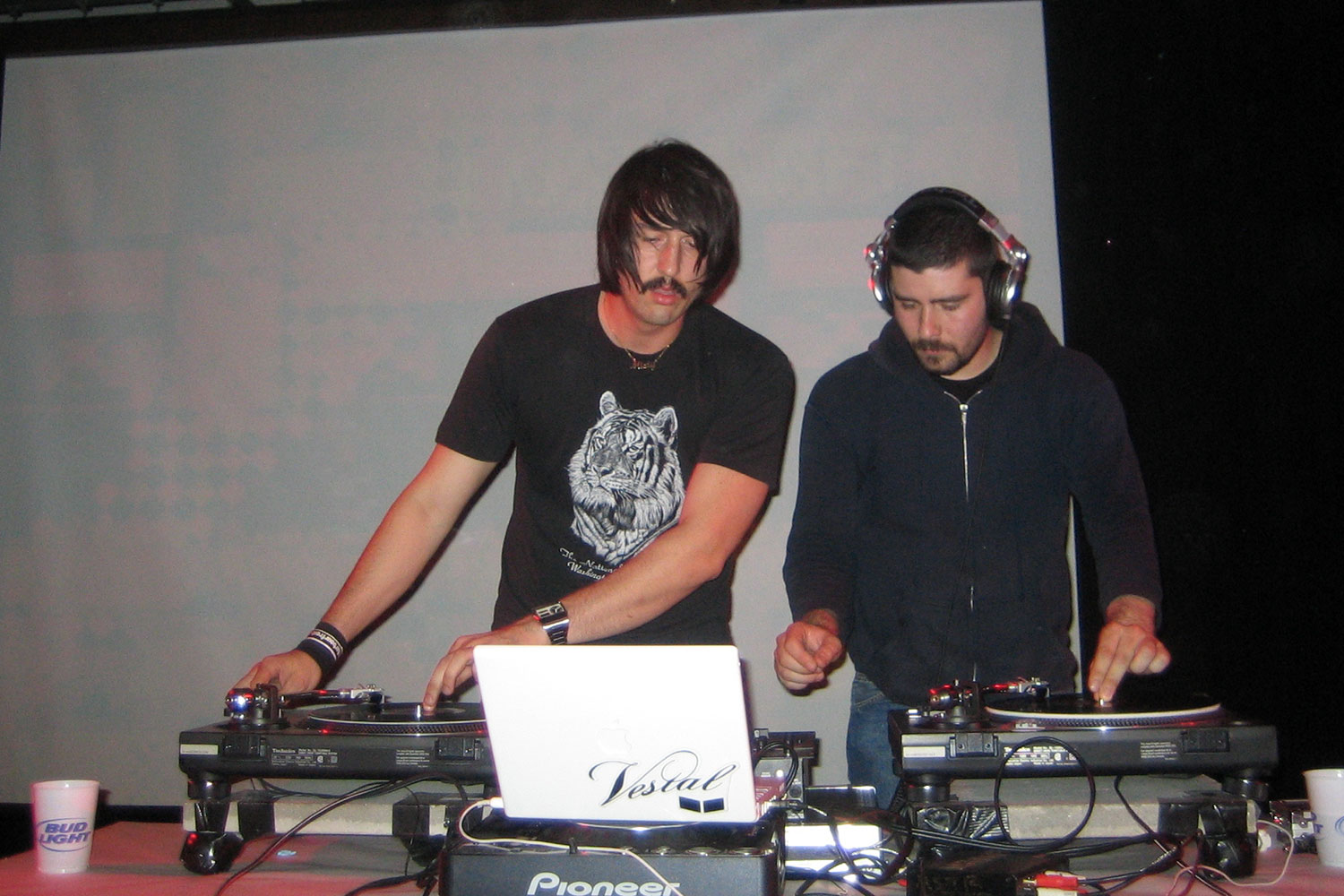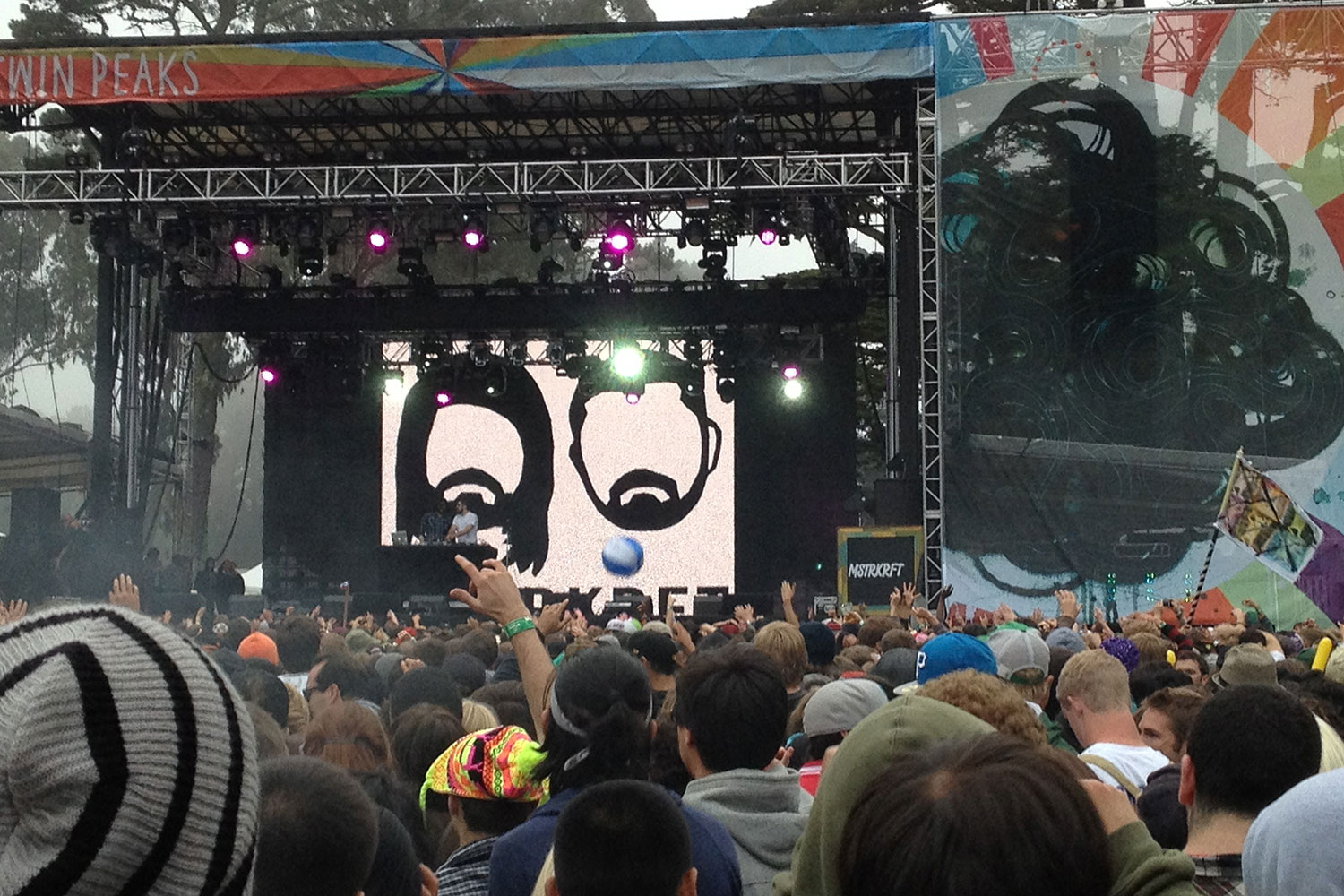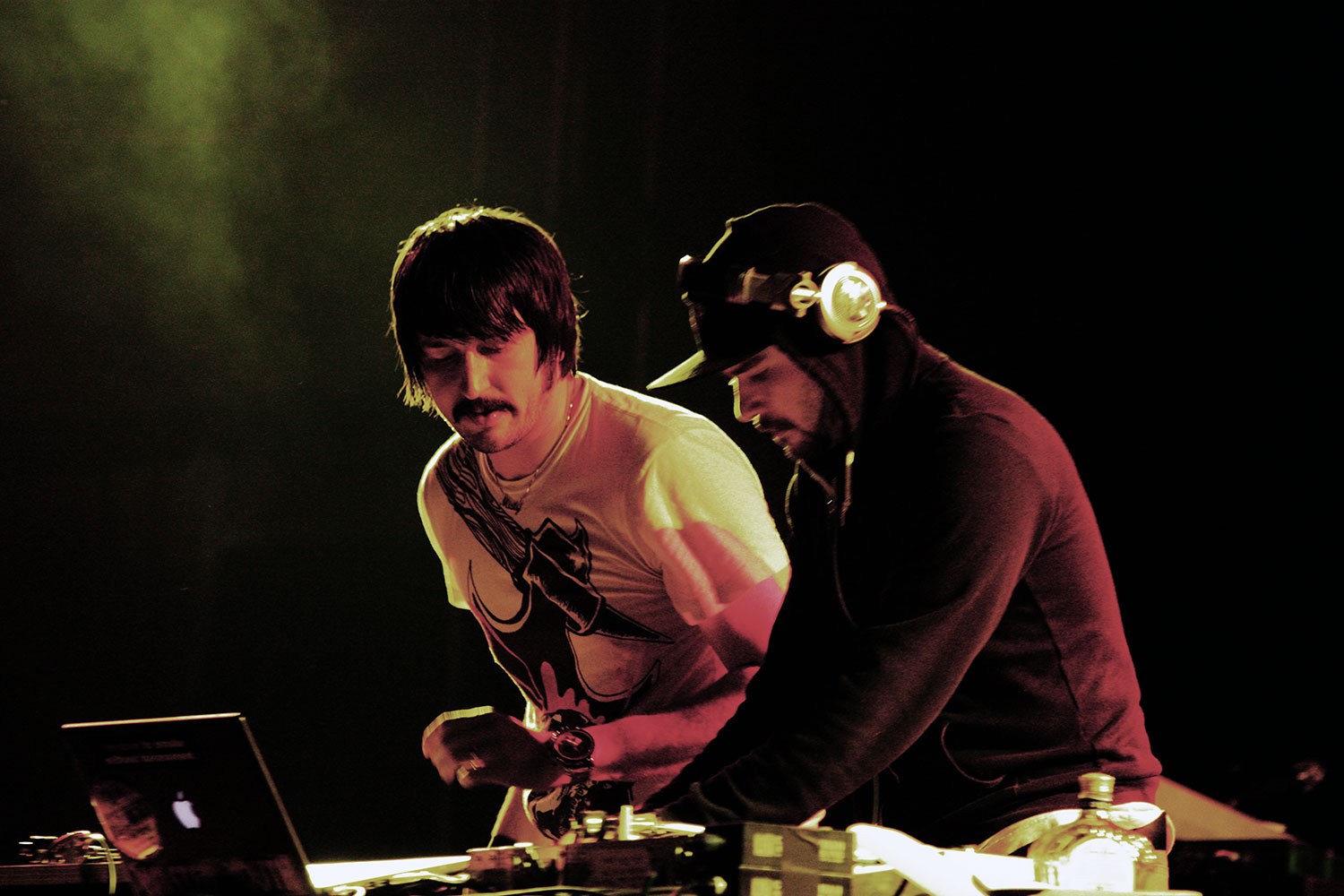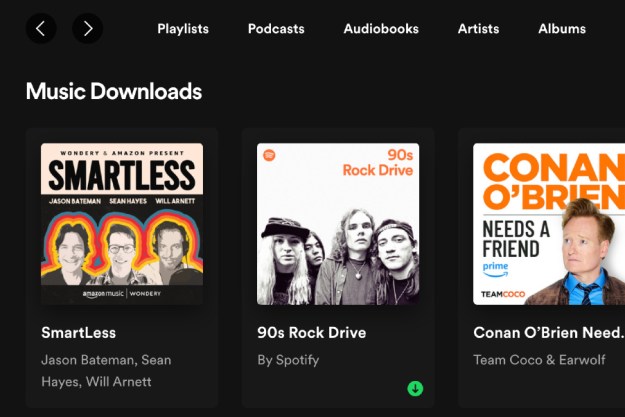
“Removing the visual component from musical creation gets you thinking in different ways.”
Balancing modern and retro sounds in electronic music can be a tricky business. That’s something the Canadian DJ duo known as MSTRKRFT understands all too well. And Jesse F. Keeler (also known for his work in Death From Above 1979) and his partner Al-P (full name: Alex Puodziukas) made damn sure of finding that balance while they were working on their first album in seven years, Operator, out now on various formats via Last Gang.
The bedrock for many an Operator song comes from the sounds MSTRKRFT got by using vintage Roland TR-707, TR-808, and TR-909s drum machines. From the whooshing, table-setting intro to Wrong Glass Sir to the sturm und clang of Priceless (featuring a guest vocal from Sonny Kay of The VSS) to the furious windup of the punk-electro clash of Go On Without Me, Operator deftly walks the fine line of being both current and classic at the same time.
“There’s a classic sound to those Roland machines, and we decided we were going to run with that sound palette and do as much as we could with those ‘fixed’ sounds,” Al-P told Digital Trends. Added Keeler, “I think it has to do with our level of comfort with the sounds we get. We’re so used to working with those machines that sometimes we’ll think, ‘Oh, I wish that sound was a little bit more like this, and had this different thing.’ But then one or the other of us will go, ‘Well, we’ve already got that. It’s right here!’”
Digital Trends called Keeler and Al-P up at their homebase in Toronto to discuss the deliberately not-smooth mixes of Operator, the benefits and the limits of hi-res recording, and why good mastering is hard to find. It’s a MSTRCLSS in action.
Digital Trends: Is it easier for artists who have just about any plug-in at their fingertips to make music these days, or is it harder when you’re working with hardcore analog gear like you guys do?
Al-P: This record is made entirely with gear. Obviously, there are some sort of convenience advantages to working in the computer — or in the box, as we would say. But in terms of the sound, and the sound design — and this may not be true for everybody, but for us it is — it’s a very stifling way to work. The mouse is like one finger. You’re trying to play with the interrelation between different modifying factors while designing a sound one finger at a time.
Maybe people are accustomed to always interacting with computers that way. I realize there are ways to get around that with controllers — red knobs on a MIDI controller to whatever the synth is — but all of the computer stuff is designed to avoid all of the errors, problems, and undesirable stuff that can happen while you’re experimenting with sound. We didn’t want any of that. We didn’t want any of those safeguards. We wanted to leave all the errors in, and leave all the noise in. There was a lot of “accepting” on our part for the way things sounded, and just running with it.
Is there one good example of a noisy, error-filled “happy accident” on Operator?
Al-P: There’s an obvious one for us called Playing With Itself. We always record everything, and there was a patch on Jesse’s modular synth pad that was producing some interesting things. We stepped out of the room to take a break, and when we came back in, we did a quick playback to listen to it. We found the machine had kept playing this evolved modular thing that we got excited about.
But when we tried to insert ourselves into it to try to refine it, everything kind of fell apart. The result was the machines did something on their own which we couldn’t have thought to do on purpose, and that’s where the song and the title come from.
I love the percussion on that song, and the way the vocals keep swirling around in the mix.
Jesse F. Keeler: That whole song is supposed to be nauseating. I love it. I love how gross and how musically unsatisfying it is, in terms of what happens with the chords.
Right — it goes unresolved.
We didn’t want any safeguards. We wanted to leave the errors in the mixes.
Keeler: Yeah. That’s this weird thing the modular patch did. I’ve tried to get back to that, and to be honest, I’ve never figured it out.
Al-P: It is interesting, because it never seemed to resolve the same way twice. It just kept going — offset just enough and cross-modulated just enough so that it was constantly evolving.
Keeler: We’ve talked about this song a lot, because the name of it is literal for us in terms of the creation of it, because we weren’t in the room when it was being recorded.
It’s a “sentient” song. I was waiting to hear, “You don’t want to do that, Dave.” (all laugh) Subconsciously, you’re waiting for that moment of resolve, and it doesn’t happen.
Al-P: In the computer, you have a grid where you can have things cycle and repeat. A lot of the songs on the album use primary intervals that are not square — using prime numbers instead of multiples of two. And that’s because by getting out of the computer screen, you can get some interesting results. We not only use that in synth programming, but in arrangements and in patterns. There’s one song that has a 3-bar loop and a 5-bar loop, and there’s another song where there’s a 7-bar loop. That’s a weird interval.
Once you have a few things doing that, you can modulate them in different ways, and things won’t come around again for 36 bars, or whatever the math is.
I’d love to see if you could take it up to 19 bars.
Al-P: We’d be getting into some real abstract music at that point! The funny thing is working on something that’s 5 bars before it reps. I don’t think when you’re listening back to the music that you’re going to notice it, because it does end up being musical in the end.
It’s just not something you would think of looking at on a computer screen, because it doesn’t make sense visually. Removing the visual component from musical creation gets you thinking in different ways. It will yield interesting results.
Are these hi-res recordings at 96/24, 48/24, or…?
Keeler: Interesting question. During the sample-rate arms race, you were getting digital converters that could do 48, and now we have 192. I did a lot of recording at higher sampling rates and have found that, especially for the music we’re making, it doesn’t really matter if we recorded at 192. A long time ago, we agreed the mastering standard for ourselves was 44.1-kHz/24-bit, because at that rate, you get high enough frequency response on the reproduction. I remember mixing a lot of times and capping things at 20,000 Hz. There’s no information we need beyond that.
The crux of the matter is going with 24-bit over 16-bit. That’s where you can really tell the difference, especially with what you do on Operator.
Keeler: That’s definitely important, because of the dynamic range.
Al-P: The way we recorded this album was with many multi-tracks of source material to edit from, and it would be silly to record them in a way that would require its own server to hold it all. There would just be too much data at 192.
Keeler: It would be silly to be taxing your system just for that extra bit of something that maybe is there, but we’re never going to hear it. So we try to keep it simple, and concise.
Al-P: A lot of the sounds within the palette are self-limiting anyway. There really isn’t the dynamic range there to notice. It’s rare that any sound goes from very quiet to very loud — it’s more just varying degrees of loud. It’s not like we’re a string quartet.
I do like hearing the fine detail of what’s going on way in the background, like you have on Morning of the Hunt.
Using a mouse is very stifling. You’re designing sound one finger at a time.
Keeler: There are some objects and environments mixed into the audio of Morning of the Hunt. We have an amazing hallway in our recording space that’s like a concrete bunker that’s maybe 60 or 80 feet long, and it just sounded amazing in there. One of the last things we did in there before we left that space was we set up a Neumann U47 [microphone] in the hall, and slammed some doors and walked up and down the hallway.
Now that I think about it, some of the drum tracks were recorded blasting in the studio with the doors open, capturing some of that hallway sound, and blending that in on the mix. It sounds super-organic. It’s an interesting environment.
I can also hear that sense of space in the last track, Go On Without Me.
Keeler: Yeah, that’s one of the ones we pumped through the hallway as well.
Al-P: We spent a lot of time on it. That song was just drums for quite a while. We actually did a lot of it on the Lexicon 480L [digital effects system].
Keeler: All the transposing of the samples happens in real time, recorded by using the slider on the 480L to create the progression. There’s just something unique about a really primitive pitch shifter. You can just grab a knob and tweak away.
Al-P: We developed an interesting vocal processing technique that we wanted to use throughout the record. It sounded really cool and it really fit the tone of the record, so it became, “OK, let’s find some words that we can pump through this processing.” That’s why there are a lot of those vocal incidentals between songs.
A lot of MSTRKRFT listeners will stream this record. How do you guys feel about the streaming universe? There’s so much going on in these songs that I hate the idea of detail being lost on the listener.
Al-P: To me, the compression of streaming itself it isn’t as big a deal as the playback of it on computer speakers. And that kind of bums me out because there’s a lot of low-end detail on this record. Unless you’re listening on speakers that go down low enough, you’re going to be missing out on some carefully composed low end. That’s the only thing that bums me out about streaming — the actual playback system, not the streaming itself.
Keeler: There are definitely some DJs on Sirius [satellite radio] who are playing low-bit MP3s, and they just don’t realize how poor they’re translating.
Last question — what about vinyl?
Keeler: Vinyl is great. To a large extent, whether stuff is being mastered for vinyl makes a huge difference — and other factors like, who cut the lacquer? What vinyl is being used? Can you see through it? Does it smell really bad? There’s all kinds of stuff.
But I’m really happy with the pressing of vinyl that we got for this album, and I’m also really happy with the master that Tom Coyne did.
Al-P: We’re very happy with Tom Coyne. I remember when we finished mixing the record, I was dreading mastering. I was really happy with the mixes, and mastering is really stressful, because you hand it over. Even if you’re attending the session, there’s still somebody else running it. It’s the last thing that’s going to happen to your music before people hear it.
Keeler: One of the reasons we’re making a big deal of this answer is for our entire career, we’d always used the same mastering engineer, Nilesh Patel at The Exchange in London. He got this amazing tone, he was affordable, and just incredible. He passed away suddenly a few years ago, and everyone was in shock. We were searching and scrambling and trying to find, well, another Nilesh, and we really believe we found him in Tom Coyne. We had maybe one revision. Somehow in the process, Tom exactly nailed how we wanted it to sound. I’ve never been happier with a master.




